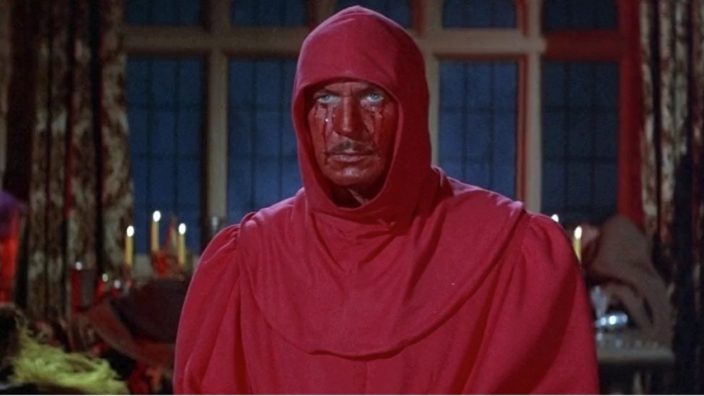




Dir: Roger Corman | Vincent Price, Hazel Court, Jane Asher, Nigel Green, Patrick Magee | Horror, US 89′
The Masque of the Red Death is the seventh in the series of Roger Corman/Edgar Allan Poe adaptations produced by AIP in the 1960s. These visually handsome films were praised for an integrity of tone, laced with dark humour; and a careful – though not over-reverential – respect for the period horror genre.
Atmospheric widescreen colour sets and costumes complimented intelligent scripts and sensitive direction. Of course, there were earlier Poe films yet it was only with the Corman features that we experience a remarkable grandeur faithful to the tone of Poe’s writings, which greatly appealed to critics and audiences.
For his ninety minute version of The Masque of the Red Death Corman takes a sparse storyline and makes it rich in atmosphere. Charles Beaumont and R. Wright Campbell worked on a plausible treatment and also added material from Poe’s tale Hop-Frog. As with the earlier Corman film The Pit and the Pendulum (an even starker one prisoner/victim situation) further characters and sub-plots needed to be created.
Alongside the Masque’s hooded figure of the Red Death (often seen as a reference to Bergman’s death character in The Seventh Seal, those monks surfacing in Bunuel’s films and the callous Prince Prospero (malevolently performed by Vincent Price) we also have a selection of court people, dwarf actors and dancers. A rival villain is provided by Patrick Magee’s Alfredo, although Magee gets short shrift in this rather underwritten role, and would have fared better as Prospero, for he conveys much darker undercurrents of evil with his bitter cracked voice and cold stare.
It made sense to move out of the hermetic court and include some villagers. Those chosen are a virtuous peasant girl Francesca (Jane Asher, ideally pure but never sentimental), her lover and her father. The men are kept inside the dungeons while Francesca, against her will, has to join the company of the court. Francesca is probed by the Satan-worshiping Prospero. He sees her belief in Christianity as equalling his attachment to the powers of darkness. Like Prospero’s mistress Juliana (Hazel Court) the peasant girl is ideal for an apprenticeship with the Devil. A quasi-initiation scene, where Vincent Price leads Jane Asher through a series of highly-coloured rooms is fascinating. Like the doors in the legend of Bluebeard’s castle, a diabolic temptation is being presented to the curious, though resistant Francesca.
These new characters are perfectly serviceable although The Masque of the Red Death tends to make them secondary to the sheer beauty of the film. And although the cast do their best, the photography, set design and costumes create an even stronger note, adding to the visual allure of the picture. Of all the Corman/Poe outings Masque is the most opulent, containing some of the most magnificent colour photography to be found in the genre (perhaps only the colour filtering and lighting in the restored Mario Bava, Kill Baby, Kill achieves a Gothic intensity equal to The Masque of the Red Death).
Nicholas Roeg won a BAFTA for his terrific work. His seductive photography is not just skin deep, it offers brilliant texture that lights up the horrible cold decadence of Prospero’s rooms, divorced from reality, and the misty presence of the village – not forgetting the hill and tree where the ominous figure of death lays out his tarot cards. Dan Haller’s set design is remarkable (they are re-used and re-decorated sets left over from the film Beckett) and so are the costumes supervised by Laura Nightingale.
Corman reportedly gave his cameraman a lighting “theme” and said that ‘Nic lit everything really very beautifully.’ So where does that leave Corman’s direction in this intense artefact? Well he directs with a fluid and elegant touch that glides you through the film. None of the performances seem obviously grand guignol. They’re very natural. And given Vincent Price’s tendency to sometimes be hammy, his Prince Prospero is as restrained as his Mathew Hopkins in Witchfinder General.
There’s a sense that Corman trusted his actors to deliver. However The Masque of the Red Death’s danse macabre scene slightly disappoints and is somewhat underwhelming. There’s a feeling of it not being adequately choreographed. Roger Corman has said he thought this sequence was a failure and he’d wished he’d had more filming time. It lacks a sense of pain and ritual, a dress rehearsal for everybody’s dreadful fate rather than the real thing.
This new blu ray comes uncut – so the flesh branding scene and Julia’s satanic hallucinations are intact. And the quality of this restoration does justice to its production values. My personal best of the Poe films still remains The Tomb of Ligiea but The Masque of the Red Death and The Fall of the House of Usher are not far behind.
According to the opening lines of Poe’s short story: “The “Red Death’ had long devastated the country. No pestilence had ever been so fatal, or so hideous. Blood was its Avatar and its seal – the redness and the horror of blood.” The partnership of Roger Corman and Nicholas Roeg gave such glorious style to this allegory, and combined with ideal casting they achieved a heightened realism to communicate the tale’s poetically despairing descriptions of both a very real, and at the same time, dream-like plague. It’s a classic horror film that’s splendidly stood the test of time. ©ALAN PRICE 2020